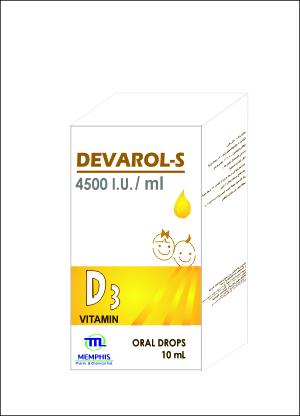COMPANY NAME: Memphis for Pharmaceutical & Chemical Industries. TRADE NAME: DEVAROL-S-4500 I.U. ORAL DROPS GENERIC NAME: Vitamin D3 COMPOSITION: Each 1 ml (=45 drops) contains: Active ingredient: Vitamin D3 4500 I.U. (Equivalent to 112.5 mcg vit. D3) Excipients: Butylated hydroxyl toluene, Kollisolv MCT 70. PHARMACEUTICAL FORM: Oral drop Solution Clear colorless to pale yellow solution free from particulate matter PHARMACOLOGICAL ACTION: The minimum requirements for vitamin D are 400-800 IU / day depending on age. Vitamin D is present naturally in the human body. The 7-dehydrocholesterol of the skin is transformed under the action of ultraviolet rays (solar radiation) into vitamin D3 (cholecalciferol). The biologically active form of vitamin D (1,25-dihydroxycholecalciferol) regulates phosphocalcic metabolism. Its main function is to promote the intestinal absorption of calcium by active transport and thus to ensure normal bone and dental growth. It performs a large number of other non-skeletal functions on different organs via specific vitamin D receptors. Vitamin D intake through diet is low. Fish liver oil and fish are rich in vitamin D and small amounts are available in meat, egg yolk, milk and dairy products. Pharmacodynamics Cholecalciferol (vitamin D3) is formed in the skin under the influence of UV rays and then converted into its active biological form (1,25-dihydroxycholecalciferol) in two hydroxylation steps, first in the liver (position 25) and then in the renal tissue (in position 1). 1,25-Dihydroxycholecalciferol is an essential part of parathyroid hormone and calcitonin regulation of the calcium phosphate balance. In case of vitamin D deficiency, calcification of the growing skeleton is lacking (rickets), or bone decalcification occurs (osteomalacia) accompanied by various manifestations of deficiency. In addition to the physiological production in the skin, cholecalciferolcan also be brought to the body through diet or in the form of pharmaceuticals. This last route bypassing the physiological inhibition of the cutaneous synthesis of vitamin D, overdoses and intoxications can occur. PHARMACOKINETICS: Absorption Vitamin D is rapidly absorbed in the proximal and distal regions of the small intestine. Distribution In the blood, it is linked to specific alpha-globulins that transport it to its main storage sites (liver and adipose tissue). Metabolism Vitamin D3 is converted to 25-hydroxycholecalciferol (25-HCC, calcifediol) in the liver. 25-HCC is then hydroxylated at the 1-position in the kidney, to give an active metabolite, 1,25-dihydroxycholecalciferol (1,25-DHCC, calcitriol). Vitamin D is stored in the body. It is eliminated mainly as inactive glucuronides. Elimination Elimination is as well by the bile and the stool as by the kidneys. INDICATIONS: • Prophylaxis of rickets. • Prophylaxis of rickets in premature infants. • Treatment of rickets. • Prophylaxis in case of an identifiable risk of vitamin D deficiency in otherwise healthy subjects with no absorption disorders. • Prophylaxis in the event of an identifiable risk of vitamin D deficiency in cases of malabsorption. • Treatment of osteomalacia. • Vitamin D3 substitution during periods of high growth, pregnancy and breastfeeding. • Treatment in case of serious vitamin D deficiency [concentrations of 25 (OH) D <25 nmol / l or 10 ng / ml].
